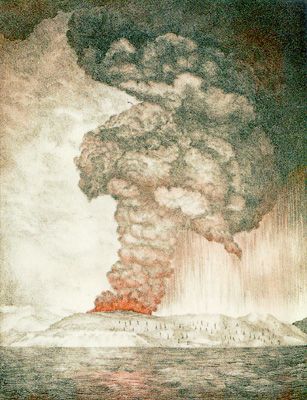January, 2005
The World's Worst Natural Disasters
Gleaned from research done by Reuters, NBC, Wikipedia, InfoPlease, Toba Volcano, by George Weber, and other sources, here, in ascending order, are the world's worst natural disasters, as they have affected humans:
- 160,000 deaths (UN estimate, ongoing) in at least a dozen Indian Ocean nations, 2004, from earthquake and tsunamis
- 200,000 deaths in China, 1920, from earthquake
- 200,000 deaths in China, 1927, from earthquake
- 300,000 deaths in China, 1642, from flooding after the failure of a major seawall
- 400,000 deaths in China, 1976, from earthquake
- 500,000 deaths in Bangladesh, 1970, from cyclone flooding (There were over 1,000,000 deaths in China, India, Pakistan, and Bangladesh combined, 1963 through 1999, from cyclone flooding. An estimated 30,000,000 people were homeless following the 1988 Bangladesh monsoon flooding alone.)
- 830,000 deaths in China, 1556, from earthquake
- 1,000,000 deaths in China, 1938-1939, from river flooding, disease, and famine
- 1,000,000 deaths worldwide, 1957, from flu
- 1,000,000 deaths worldwide, 1968, from flu
- 1,100,000 deaths in Egypt and Syria, 1201, from earthquakes
- 1,500,000 deaths in India, 1965-1967, from drought-related famine
- 2,000,000 deaths in China, 1887, from river flooding, disease, and famine
- at least 2,000,000 deaths in China, 1959, from river flooding, disease, and famine
- 2,000,000-3,000,000 deaths worldwide, each year, from malaria
- 3,000,000 deaths in India, 1900, from drought-related famine
- 3,000,000 deaths in China, 1941, from drought-related famine
- 3,700,000 deaths in China, 1931, from river flooding, disease, and famine
- 10,000,000 deaths in China, 1892-1896, from Bubonic Plague
- 19,000,000 deaths worldwide, 1981 to present, from AIDS
- 25,000,000 (official estimates)-100,000,000 (most agree the higher estimate more likely) deaths worldwide, 1918-1919, from flu
- 55,000,000 deaths in Europe and Asia, 1300s, from Black Death
- up to 100,000,000 deaths (a controversial estimate) in Europe, 540-590, from Justinian Plague
- 300,000,000-500,000,000 deaths worldwide, 20th Century alone, from smallpox (Historically, this disease is thought to have been responsible, at least in Europe, for as many deaths as the plague. It was a great scourge in whole populations during several periods through history, cutting down about one-third in Rome in the early period A.D. and decimating the majority of the members of several American Indian tribes in the 16th through 19th Centuries. Up till the last diagnosed case, in 1977, it still was a greater killer by far, in the 20th Century, than all the wars combined.)
- The Toba supervolcano eruption, in what is now Sumatra, Indonesia, about 74,000 years ago. This single event killed most of our human ancestors. Based on our genetic heritage from that time, estimates vary but coalesce in the range of only 40-500 individual female Homo sapiens of child bearing age (suggesting a total human population of just a few hundred to several thousand) having survived both Toba's initial supervolcanic cataclysm and the subsequent volcanic winter, which plummeted temperatures worldwide.

Krakatoa erupting, 1883 |
(Several competing hominid species apparently were completely wiped out by the Toba eruption and its effects.)
While it is clear the 12/26/04 devastations do not rank even among the dozen worst natural disasters, they represent certainly the deadliest tsunami-related tragedy within recorded history. The nearest two, in numbers of people killed by other tsunamis, are: first, in 1755, when 100,000 died in Portugal and Morocco from earthquake, tsunamis, and fire calamities; and, second, in 1883, when 36,000 died after the stupefying eruption of Krakatoa, in Indonesia, followed by tsunamis that affected that region much as did the most recent events.
But while the 160,000 or so deaths in the current catastrophe are a quite exceptional absolute number of tsunami-related victims, as a proportion of the existing world population, they stand only 2nd among the three major tsunami-related disasters of fairly modern times. The cited 1755 events, when earth's human population would have been only about 700 million, killed roughly .014% of the world's people. By comparison, those in 1883, when the globe's total number of people were about 1.45 billion, though perhaps morbidly fascinating for the spectacular Krakatoa volcanism with which they began, killed just roughly .002% of the then total population. If the current tsunami-related fiascos' final figure for people dead winds up being about 160,000, they will have killed .003% of our current 6 billion+ total population, less than 1/4 as severe, in those terms, as the Portugal/Morocco disaster.
Such statistics are irrelevant, of course, to the overwhelming and horrendous nature of the disasters for those directly affected and for the national economies of the many nations where this latest earthquake and/or the subsequent tsunamis struck. It is fortunate, then, that another singular aspect of the current, otherwise appalling events has been the remarkable way in which individuals, aid organizations, corporations, and governments have been generously donating their time, volunteer efforts, essential supplies, logistical support, and money to help the surviving people and their countries deal with what has occurred.
|
